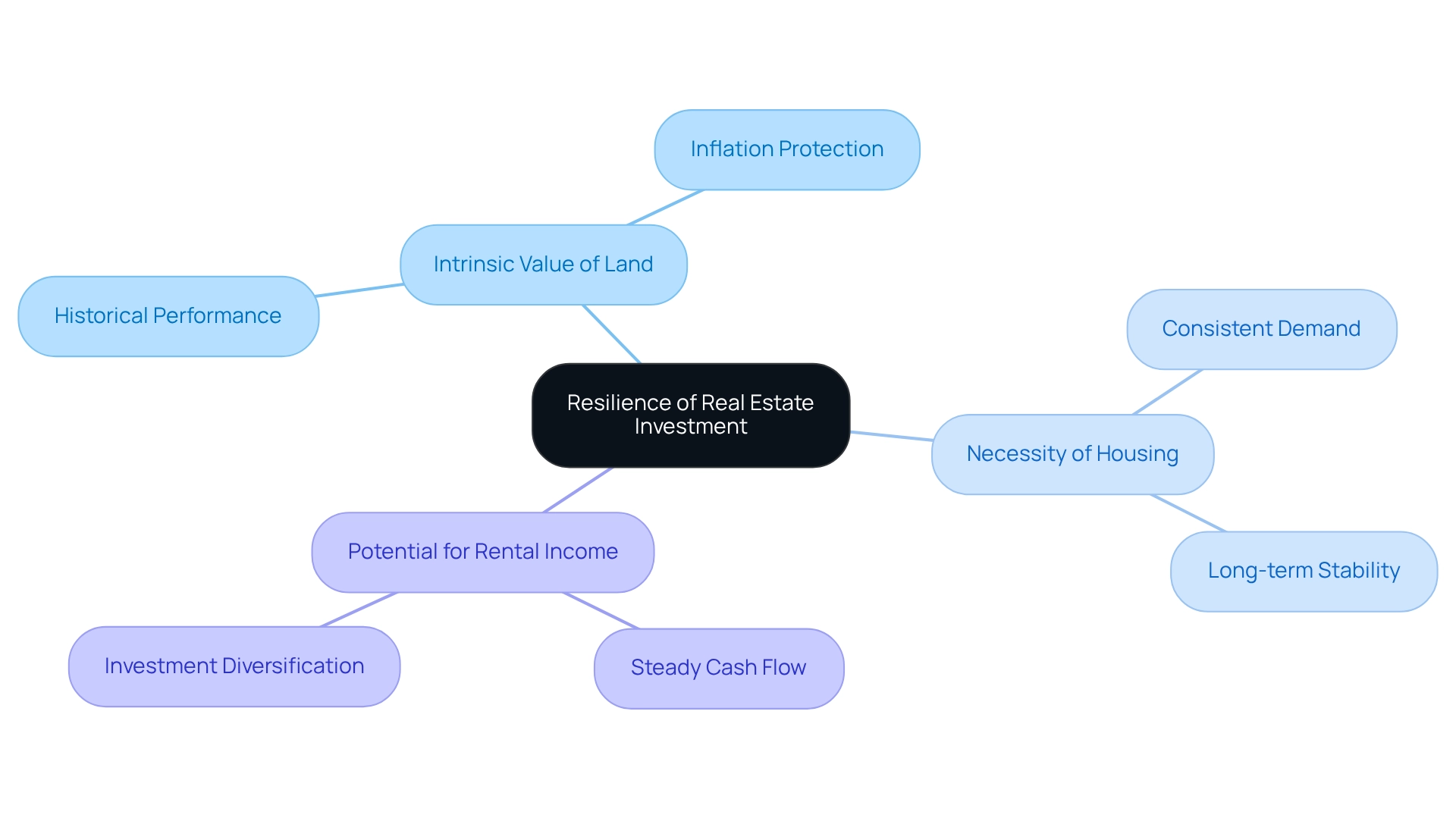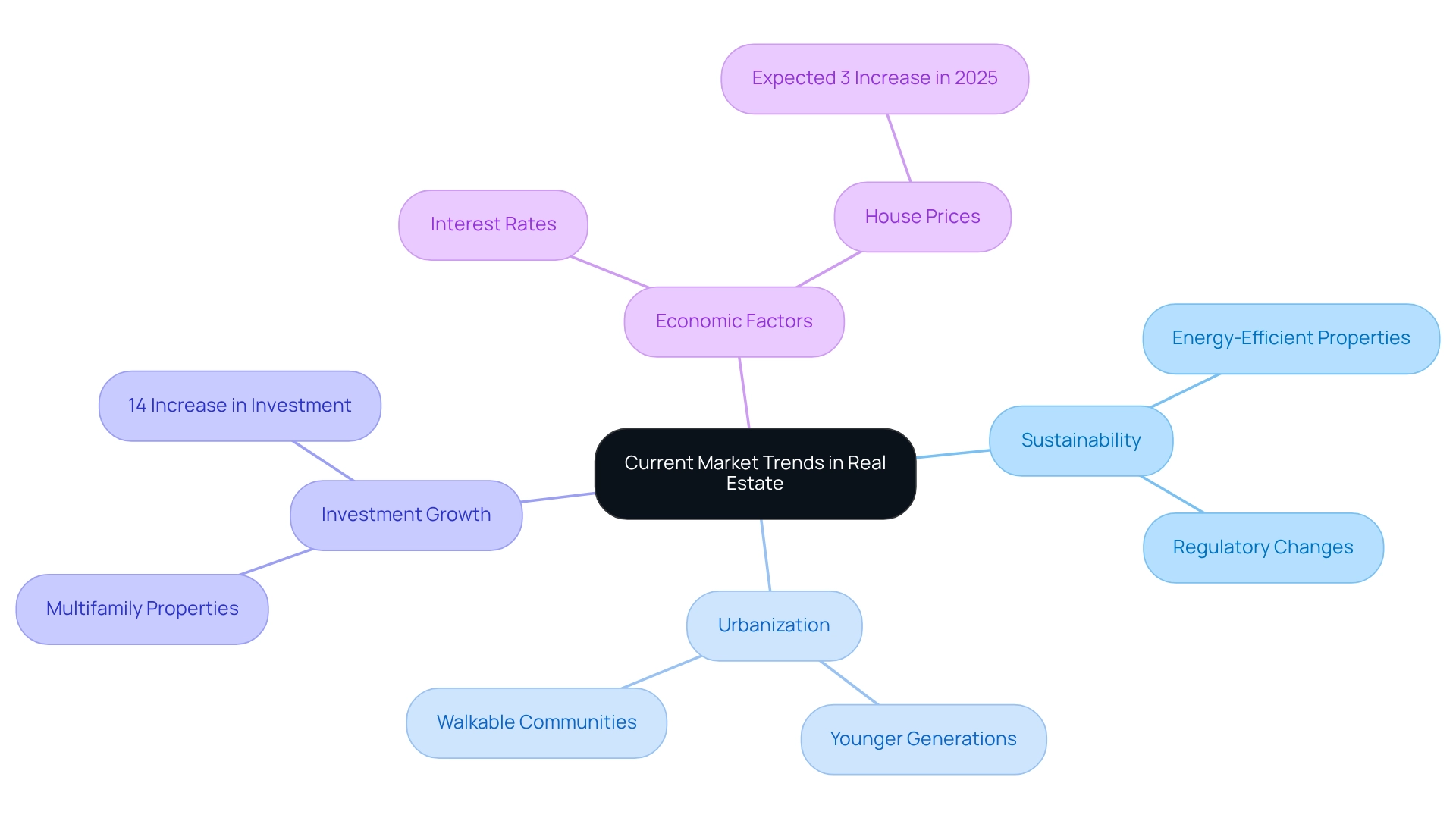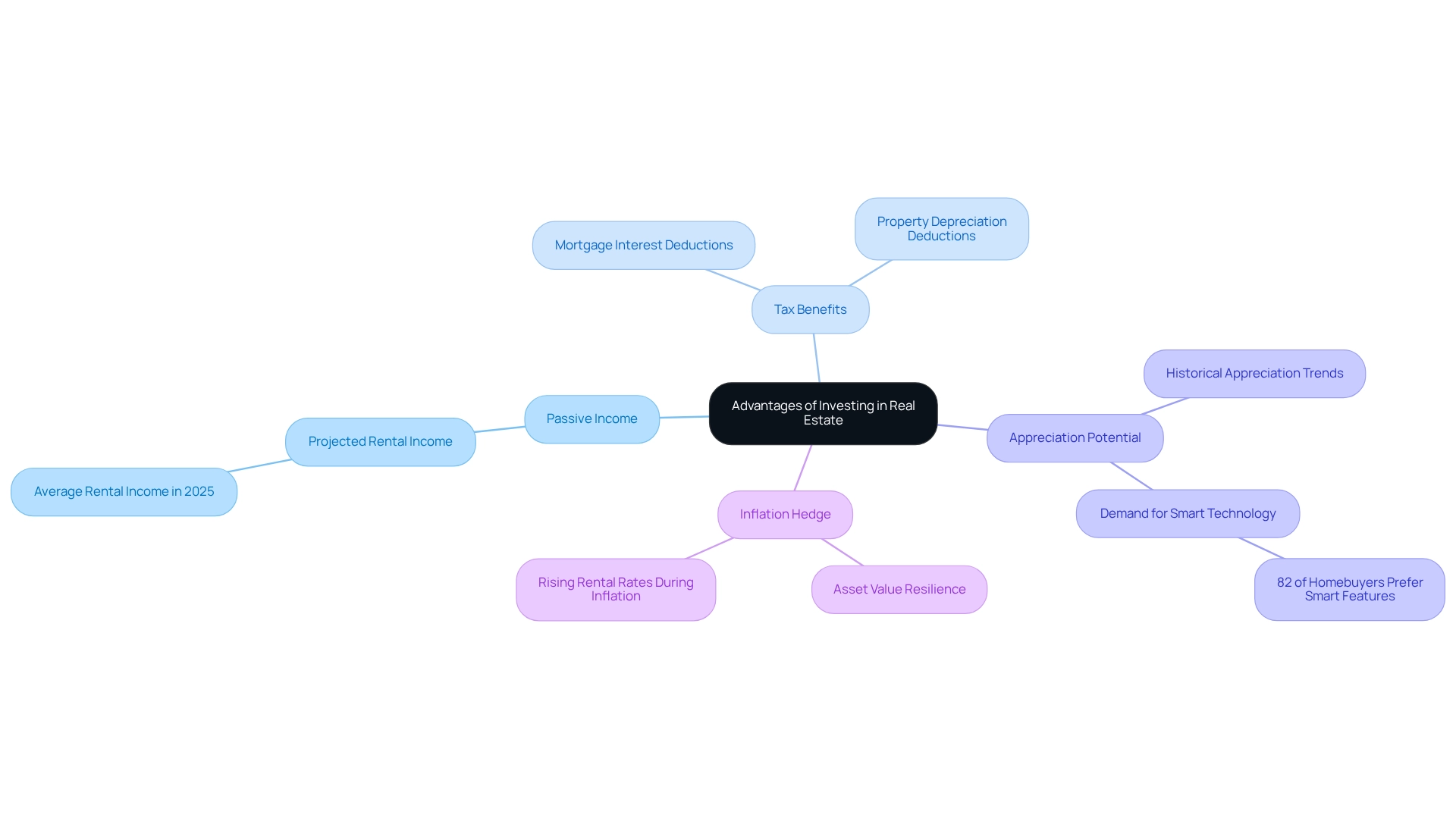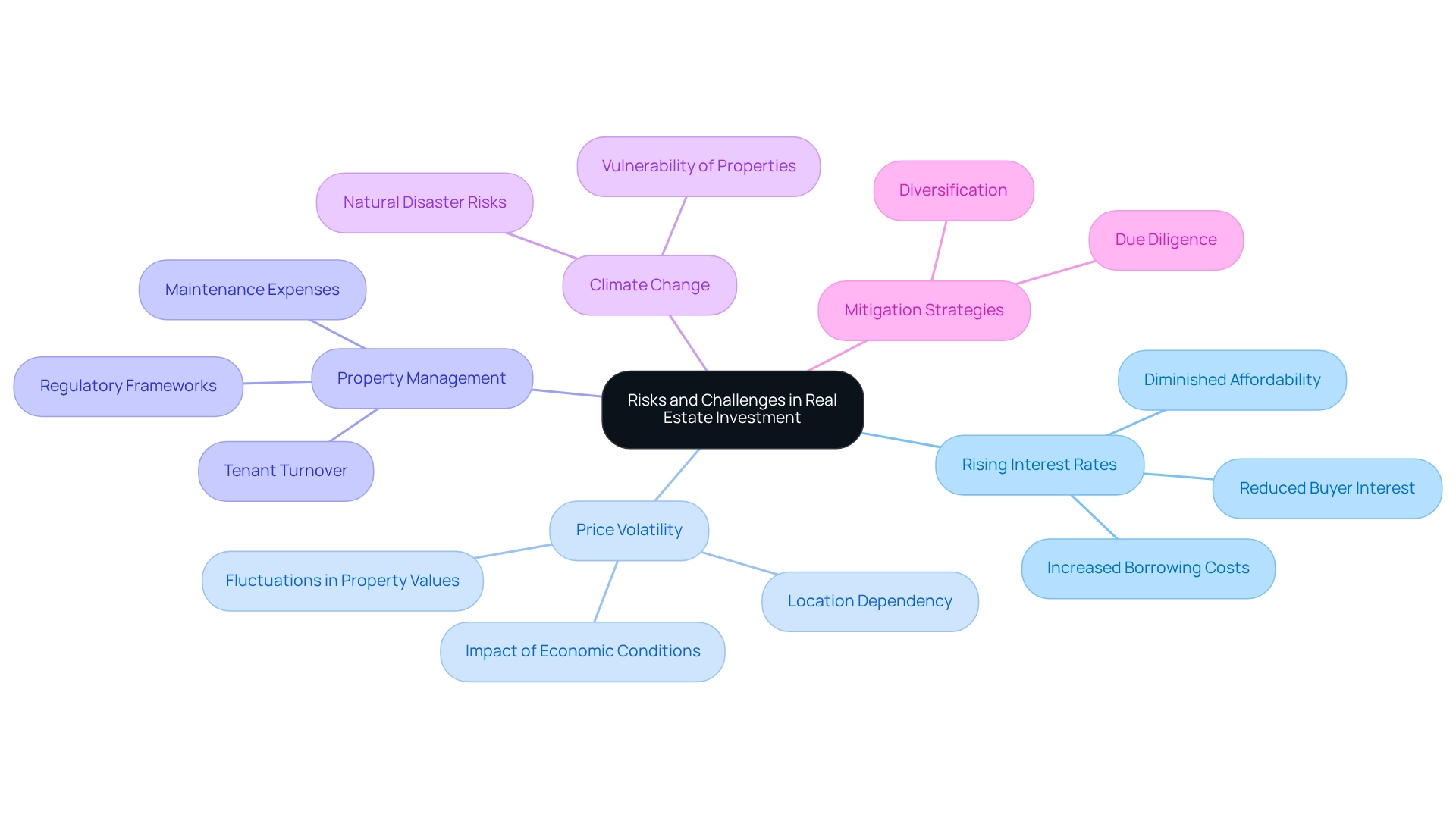Overview
Real estate continues to be a sound investment choice, attributed to its intrinsic value, potential for rental income, and historical resilience during economic downturns. This resilience persists even amidst current market challenges, such as rising interest rates. Evidence of this is found in the:
- Long-term appreciation of properties
- Increasing demand for sustainable living options
- Substantial tax benefits that collectively enhance overall returns for investors
By understanding these factors, investors can make informed decisions that align with market trends and capitalize on the enduring value of real estate.
Introduction
In the ever-evolving landscape of real estate investment, grasping the nuances of resilience, market trends, and potential challenges is essential for both novice and seasoned investors. Real estate has long been recognized for its capacity to endure economic fluctuations, often outperforming other asset classes during downturns.
As we approach 2025, a variety of transformative trends are poised to reshape the market, including:
- The rise of sustainable properties
- Shifting demographic preferences
However, these opportunities are accompanied by significant risks, including:
- Rising interest rates
- Market volatility
This article explores the multifaceted world of real estate investment, examining its enduring advantages, current market dynamics, and the inherent challenges investors must navigate to secure their financial futures.
Understanding the Resilience of Real Estate Investment
Real property has consistently demonstrated its resilience as an investment, leading many to wonder, is real estate still a good investment, especially as it frequently outperforms other asset classes during economic downturns. This resilience can be attributed to several key factors:
- The intrinsic value of land
- The necessity of housing
- The potential for rental income
Unlike shares, which can exhibit considerable fluctuations, property generally appreciates over time, serving as a safeguard against inflation. The physical characteristics of property assets also provide a sense of security for investors, making it a preferred option in unpredictable economic conditions.
For instance, during the 2008 financial crisis, while numerous sectors suffered significant losses, properties in prime locations maintained their value, illustrating the resilience of property holdings. Notable property investment trusts (REITs) such as Simon Property Group, Digital Realty Trust, and Annaly Capital Management exemplify the diversity within the sector, showcasing the potential for investment across various property types.
As we look toward 2025, the durability of property remains evident. Investors are encouraged to adopt a long-term perspective, which can help mitigate the risks associated with short-term economic fluctuations. Historical performance data indicates that property ventures have not only withstood economic challenges but have also yielded substantial returns over time, leading to the consideration of whether real estate is still a good investment for those seeking to accumulate wealth sustainably. This enduring appeal is further supported by expert insights emphasizing that investors should carefully assess their financial goals and risk tolerance in relation to current market conditions. Additionally, Zero Flux curates data from over 100 diverse sources, ensuring that the insights presented are credible and comprehensive.

Analyzing Current Market Trends Impacting Real Estate
As 2025 progresses, several crucial trends are transforming the property landscape. A prominent focus is on sustainable and energy-efficient properties, driven by stricter regulations and heightened environmental awareness. Investors are increasingly prioritizing properties that not only comply with current standards but also anticipate future regulatory changes. This shift is underscored by a notable rise in investment in multifamily properties, which increased by 14% compared to the previous year, reflecting a robust demand for sustainable living options.
Additionally, the demographic trend towards urban living continues to drive demand, particularly among younger generations who prefer walkable communities with convenient access to amenities. This urbanization trend is further supported by the projection that the global real estate sector will reach $5,388.87 billion by 2026, growing at a compound annual growth rate (CAGR) of 9.6%. Such growth indicates a resilient future for the sector, despite current challenges. However, 36.25% of individuals believe that Trump's policies for inflation and tariffs will negatively affect economic recovery in 2025, adding a layer of complexity to the financial environment.
The financial environment, marked by fluctuating interest rates, is also influencing buyer behavior. While house prices are expected to increase by about 3% in 2025, elevated interest rates may discourage some prospective buyers, resulting in a more competitive environment for rental properties. Grasping these dynamics is essential for investors seeking to determine if real estate is still a good investment while maneuvering through the intricacies of the property sector efficiently, especially considering the growing focus on sustainable investments and urban living trends. Furthermore, comparisons of sale data and inventory levels across states will provide additional insights into market conditions, enhancing the overall understanding of the current landscape.

Exploring the Advantages of Investing in Real Estate
Investing in property presents a multitude of benefits that appeal to both novice and seasoned investors. A primary advantage lies in the potential for passive income through rental properties, which can generate a consistent cash flow. In 2025, the average rental income for well-located properties is projected to be around $2,500 per month, making them an enticing option for income-seeking investors.
Moreover, property purchases often provide significant tax benefits. Investors can take advantage of deductions for mortgage interest and property depreciation, which can enhance overall returns. For instance, statistics reveal that these deductions can substantially reduce taxable income, allowing investors to retain a greater portion of their earnings.
Real estate also serves as a tangible asset that appreciates in value over time, offering opportunities for capital gains. Properties located in high-demand areas have historically demonstrated remarkable appreciation, solidifying their status as profitable long-term investments. Notably, 82% of homebuyers prefer homes equipped with smart technology features, indicating a trend towards modern amenities that can further elevate property value.
Furthermore, real estate acts as a hedge against inflation, as asset values and rental rates typically rise during inflationary periods. This resilience renders real estate an attractive option in 2025, especially as signs of recovery emerge, with increased buyer interest and reduced average time on the market despite elevated mortgage rates. As Joy Aumann, a licensed realtor and interior designer, notes, "Condos still attract buyers seeking a low-maintenance lifestyle, but I always advise my clients to think long-term," underscoring the importance of considering future trends in the industry.
It's also crucial to recognize that owners of rental properties generally do not utilize them as primary residences, allowing them to focus on income generation rather than personal use.
In summary, the combination of income generation, tax advantages, and appreciation potential raises the question of whether real estate is still a good investment, particularly in the current economic landscape.

Evaluating Risks and Challenges in Real Estate Investment
While real estate investment offers numerous advantages, it also leads to the question of whether real estate is still a good investment, considering the significant risks and challenges that investors must adeptly navigate. A primary concern is whether real estate is still a good investment, considering the impact of rising interest rates, which can elevate borrowing costs and diminish affordability for prospective buyers. Current evaluations suggest that high mortgage rates are expected to persist into 2025, leading many to question if real estate is still a good investment, as it may reduce buyer interest and result in a decrease in market activity. Price volatility further complicates the landscape, resulting in fluctuations in property values, particularly in regions heavily dependent on specific industries or economic conditions. For instance, properties in areas experiencing economic downturns may face more substantial declines in value, underscoring the importance of location and economic trends.
Investors must also remain cognizant of the inherent risks associated with property management. Factors such as maintenance expenses, tenant turnover, and evolving regulatory frameworks can significantly impact rental income and overall returns. Furthermore, the ongoing effects of climate change raise concerns about whether real estate is still a good investment, particularly for properties located in vulnerable areas that are susceptible to natural disasters. To effectively navigate these challenges, investors should implement strategies that mitigate risks.
- Diversifying portfolios across various asset classes and geographic regions can help cushion the impact of market fluctuations.
- Conducting thorough due diligence prior to making investment decisions is crucial, as it enables investors to evaluate potential risks and opportunities more accurately.
Notably, Gatsby Investment has delivered an average yearly net return of 22% to investors from 2016 to 2024, serving as a benchmark for assessing potential returns against the aforementioned risks.
Additionally, the global property sector is projected to reach $5,388.87 billion by 2026, expanding at a CAGR of 9.6%. This broader context of growth may influence investor sentiment even amidst rising interest rates. The importance of expert advice from seasoned professionals, such as Jack Stapleton from Realty Texas, cannot be overstated in achieving property goals during these fluctuating interest rates. By remaining informed and proactive, investors can position themselves to capitalize on available opportunities while minimizing exposure to the inherent risks of the real estate market.

Conclusion
The landscape of real estate investment presents a compelling blend of resilience, emerging trends, and inherent challenges that shape investor decisions. Real estate has long been recognized for its stability, often outperforming other asset classes during economic downturns due to its intrinsic value and potential for rental income. The shift toward sustainable properties, coupled with changing demographic preferences, enriches the market, offering unique opportunities for those willing to adapt to evolving consumer demands.
However, the path to successful real estate investment is fraught with hurdles. Rising interest rates and market volatility introduce significant risks that can affect buyer behavior and property values. Investors must remain vigilant and informed, employing strategies such as:
- Diversification
- Thorough due diligence
to navigate these complexities effectively. The projected growth of the global real estate market highlights the potential rewards of investing in this sector, yet it necessitates a proactive approach to mitigate risks associated with economic fluctuations and changing regulations.
Ultimately, the real estate market in 2025 offers a compelling mix of advantages and challenges. By understanding the dynamics at play and aligning investment strategies with market trends, individuals can position themselves to reap the benefits of this enduring asset class while safeguarding their financial futures. Embracing a long-term perspective and staying attuned to market developments will be crucial for successfully navigating the multifaceted world of real estate investment.




